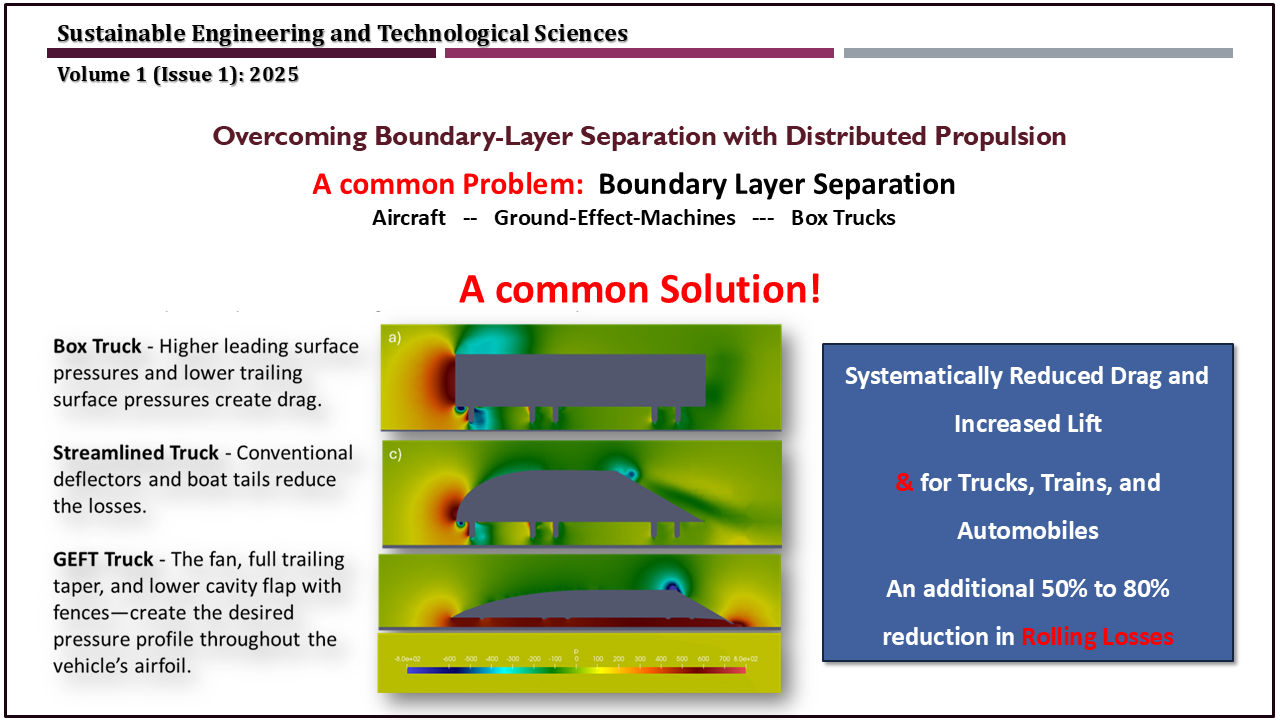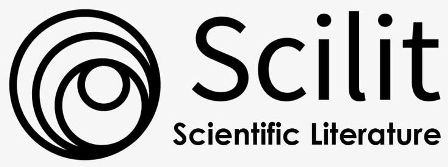Overcoming Boundary-Layer Separation with Distributed Propulsion
DOI:
https://doi.org/10.70516/7a9e2y30Keywords:
Aircraft, Trucks; Efficiency, Lift; Drag, Rolling Losses, Mechanical Resistance, Distributed PropulsionAbstract
Strategically located propulsors are able to create constructive interference on aircraft; increasing lift, lift-drag ratios (L/D), and resilience to boundary layer separation. Computational fluid dynamic (CFD) studies teach toward an optimal configuration with a near-zero upper-surface pitch in front of a trailing section propulsor followed by a trailing taper with 20° to 45° surface pitch from the propulsor to a trailing edge near the bottom of the lifting body (“Lift Span Tech”). Applications benefiting from Lift Span Tech range from box trucks to high-speed intercontinental transit. With initial propulsor power mitigating boundary layer separation, Lift Span Tech provides a high gain:loss, where the gain is in reduced drag and loss is reduced thrust from the propulsor. Performance may be augmented with ground effect further improving L/D efficiency. This study evaluates the sensitivity of performance to different CFD turbulence models and trailing taper pitches. While today’s commercial approaches can reduce truck drag by about 34% with no impact on wheel friction, new Lift Span Tech is able to reduce drag by up to 84% and wheel friction by up to 90%. The technology enables designs to allow direct solar power to fully replace liquid fuels in a wide range of vehicles.
Downloads
References
Abbas, Z., Mansoor, M., Habib, M., and Mehmood, Z., "Review: MEMS sensors for flow separation detection," Microsystem Technologies, Vol. 29, No. 9, 2023, pp. 1253–1280. 10.1007/s00542-023-05513-x DOI: https://doi.org/10.1007/s00542-023-05513-x
Simpson, R.L., "untitled," Ann. Rev. Fluid Mech., Vol. 21, 1989, pp. 205–34. DOI: https://doi.org/10.1146/annurev.fluid.21.1.205
Veerasamy, D., Atkin, C.J., and Ponnusami, S.A., "Aerofoil wake-induced transition characteristics on a flat-plate boundary layer," Journal of Fluid Mechanics, Vol. 920, 2021, pp. A29. 10.1017/jfm.2021.452 DOI: https://doi.org/10.1017/jfm.2021.452
Cotte, B., Roy, S., Raus, D., and Oueini, R., "Towards a semi-empirical trailing edge noise model valid for attached and separated turbulent boundary layers," 28th AIAA/CEAS Aeroacoustics 2022 Conference, 2022, https://doi.org/10.2514/6.2022-3103 DOI: https://doi.org/10.2514/6.2022-3103
Rodriguez, I., Lehmkuhl, O., and Borrell, R., "Effects of the Actuation on the Boundary Layer of an Airfoil at Reynolds Number Re = 60000," Flow, Turbulence and Combustion, Vol. 105, No. 2, 2020, pp. 607–626. 10.1007/s10494-020-00160-y DOI: https://doi.org/10.1007/s10494-020-00160-y
Kumar, K., Kumar, P., and Singh, S.K., "PASSIVE CONTROL OF BOUNDARY LAYER SEPARATION USING SINGLE AND MULTIPLE SLATS ON THE AIRFOIL," International Journal of Fluid Mechanics Research, Vol. 48, No. 2, 2021, 10.1615/InterJFluidMechRes.2021033106 DOI: https://doi.org/10.1615/InterJFluidMechRes.2021033106
Jarmon, C.M., Lang, A.W., and Hubner, J., "Wind Tunnel Investigations of Sharkskin Inspired Passive Flow Control Devices," AIAA SciTech 2024 Forum, 2024, https://doi.org/10.2514/6.2024-1938 DOI: https://doi.org/10.2514/6.2024-1938
Cross, A., "Experimental Investigations into Shark Skin Inspired Active Flow Control Mechanisms," 2022, https://www.proquest.com/openview/9e436ff604c8239aed2a2df17af8ca27/1?pq-origsite=gscholar&cbl=18750&diss=y
Huang, W., Wu, H., Yang, Y., Yan, L., and Li, S., "Recent advances in the shock wave/boundary layer interaction and its control in internal and external flows," Acta Astronautica, Vol. 174, 2020, pp. 103–122. 10.1016/j.actaastro.2020.05.001 DOI: https://doi.org/10.1016/j.actaastro.2020.05.001
Atik, H., Kim, C.-., Dommelen, L.L.V., and Walker, J.D.A., "Boundary-layer separation control on a thin airfoil using local suction," Journal of Fluid Mechanics, Vol. 535, 2005, pp. 415–443. 10.1017/S002211200500501X DOI: https://doi.org/10.1017/S002211200500501X
Wang, A., and Lai, H., "Control of separated flow at low Reynolds number around NACA0012 airfoil by boundary layer suction," Journal of Physics: Conference Series, Vol. 2707, 2024, pp. 012122. 10.1088/1742-6596/2707/1/012122 DOI: https://doi.org/10.1088/1742-6596/2707/1/012122
Mirhashemi, A., Chapman, J.W., Miller, C.J., "Tail-mounted engine Architecture and Design for the Subsonic Single Aft Engine Electrofan Aircraft," San Diego, CA,
Jansen, R.H., Kiris, C.C., Chau, T., "Subsonic Single Aft Engine (SUSAN) Transport Aircraft Concept and Trade Space Exploration," San Diego, California,
Russo, O., and Aprovitola A, de Rosa D, Pezzella G, Viviani A., "Computational Fluid Dynamics analyses of a wing with distributed electric propulsion," Aerospace, Vol. 10, No. 1, 2022, https://doi.org/10.3390/aerospace10010064 DOI: https://doi.org/10.3390/aerospace10010064
Serrano, J., Tiseira, A., García-Cuevas, L., and Varela, P., "Computational Study of the Propeller Position Effects in Wing-Mounted, Distributed Electric Propulsion with Boundary Layer Ingestion in a 25 kg Remotely Piloted Aircraft," Drones, Vol. 5, 2021, pp. 56. 10.3390/drones5030056 DOI: https://doi.org/10.3390/drones5030056
Gohardani, A., Doulgeris, G., and Singh, R., "Challenges of future aircraft propulsion: A review of distributed propulsion technology and its potential application for the all electric commercial aircraft," Progress in Aerospace Sciences, Vol. 47, 2011, pp. 369–391. 10.1016/j.paerosci.2010.09.001 DOI: https://doi.org/10.1016/j.paerosci.2010.09.001
Pascual, B. R., Vos, R., "The Effect of Engine Location on the Aerodynamic Efficiency of a Flying-V Aircraft | AIAA SciTech Forum," 2020, https://arc.aiaa.org/doi/10.2514/6.2020-1954
Snyder, M.H., Zumwalt, G.W., "Effects of wingtip-mounted propellers on wing lift and induced drag. | Journal of Aircraft," J. Aircraft, Vol. 6, No. 5, 1969, pp. 392–397. DOI: https://doi.org/10.2514/3.44076
Erhard, R., Clarke, M., and Alonso, J., "A Low-Cost Aero-Propulsive Analysis of Distributed Electric Propulsion Aircraft," January 11, 2021, 10.2514/6.2021-1200 DOI: https://doi.org/10.2514/6.2021-1200
Cunningham, M., Nigam, N., Ayyalasomayajula, S., "Integrated Vehicle-Propulsion-Control Design Architecture for Distributed Electric Propulsion-Enabled Aircraft," 2022-06-27, 10.2514/6.2022-3484 DOI: https://doi.org/10.2514/6.2022-3484
Loth, J., Loth, F., "Induced drag reduction with wing tip mounted propellers | Fluid Dynamics and Co-located Conferences," AIAA 2nd Applied Aerodynamics Conference, August, 1984, pp. 1–8. DOI: https://doi.org/10.2514/6.1984-2149
Sinnige, T., van Arnhem, N., Stokkermans, T. C. A., Eitelberg, G., Veldhuis, L.M., "Wingtip-Mounted Propellers: Aerodynamic Analysis of Interaction Effects and Comparison with Conventional Layout | Journal of Aircraft," J. Aircraft, Vol. 56, No. 1, 2019, pp. 295–312. DOI: https://doi.org/10.2514/1.C034978
Cole, J., Krebs, T., Barcelos, D., and Bramesfeld, G., "Influence of Propeller Location, Diameter, and Rotation Direction on Aerodynamic Efficiency," Journal of Aircraft, Vol. 58, 2020, pp. 1–9. 10.2514/1.C035917 DOI: https://doi.org/10.2514/1.C035917
Krishna, Y.C., and Venkatesh, T.N., "Numerical investigation of aerodynamically efficient wing tip-mounted propeller configuration using coupled RANS–BEM approach," Aircraft Engineering and Aerospace Technology, Vol. 95, 2023, 10.1108/AEAT-09-2022-0254 DOI: https://doi.org/10.1108/AEAT-09-2022-0254
Kim, H.D., Perry, A.T., and Ansell, P.J., "A Review of Distributed Electric Propulsion Concepts for Air Vehicle Technology," 2018 AIAA/IEEE Electric Aircraft Technologies Symposium (EATS), 2018, pp. 1–21. 10.2514/6.2018-4998 DOI: https://doi.org/10.2514/6.2018-4998
Zhang, X, Zhang, W., Li, W., Zhang, X., Lei, T., "Experimental research on aero-propulsion coupling characteristics of a distributed electric propulsion aircraft - ScienceDirect," Chinese Journal of Aeronautics, Vol. 36, No. 2, 2023, pp. 201–212. DOI: https://doi.org/10.1016/j.cja.2022.07.024
Suppes, A., and Suppes, G., "Thermodynamic Analysis of Distributed Propulsion," Research Square, 2023, pp. 1–26. 10.21203/rs.3.rs-4670270/v1 DOI: https://doi.org/10.21203/rs.3.rs-4670270/v1
Suppes, G., and Suppes, A., "Critical Data and Thinking in Ground Effect Vehicle Design," Cambridge University Press, Cambridge Open Engage, 2024. https://www.cambridge.org/engage/https://doi.org/10.33774/coe-2024-76mzx DOI: https://doi.org/10.33774/coe-2024-76mzx
Bulat, P., Chernyshov, P., Prodan, N., and Volkov, K., "Control of Aerodynamic Characteristics of Thick Airfoils at Low Reynolds Numbers Using Methods of Boundary Layer Control," Fluids, Vol. 9, No. 1, 2024, pp. 26. 10.3390/fluids9010026 DOI: https://doi.org/10.3390/fluids9010026
Deviparameswari, K., Meenakshi, S., Akshay Kumar, N., Vigneshwaran, R., Rohini Janaki, B., Vinsiya Maria, A., Keerthana, N., Surya, B., Vetrivel, M., Thianesh, U.K., Rajarajan, S., Manikandan, P., "The Effects of Ground Clearance and Boundary Layer Blockage Factor on the Aerodynamics Performance of the Hyperloop Pod and Transonic Ground-Effect Aircraft | AIAA AVIATION Forum," AIAA Aviation Forum, 2021, https://doi.org/10.2514/6.2021-2586 DOI: https://doi.org/10.2514/6.2021-2586
Qu, Q., Wang, W., Liu, P., and Agarwal, R.K., "Airfoil Aerodynamics in Ground Effect for Wide Range of Angles of Attack," AIAA Journal, Vol. 53, No. 4, 2015, https://doi.org/10.2514/1.J053366 DOI: https://doi.org/10.2514/1.J053366
Qu, Q., Zuo, P., Wang, W., Liu, P., and Agarwal, R.K., "Numerical Investigation of the Aerodynamics of an Airfoil in Mutational Ground Effect," AIAA Jouranl, Vol. 53, 2015, https://doi.org/10.2514/1.J054155 DOI: https://doi.org/10.2514/6.2015-0256
Lee, S., and Lee, J., "Aerodynamic analysis and multi-objective optimization of wings in ground effect," Ocean Engineering, Vol. 68, 2013, pp. 1–13. https://doi.org/10.1016/j.oceaneng.2013.04.018 DOI: https://doi.org/10.1016/j.oceaneng.2013.04.018
Lee, S., and Lee, J., "Optimization of Three-Dimensional Wings in Ground Effect Using Multiobjective Genetic Algorithm," Journal of Aircraft, Vol. 48, No. 5, 2012, https://doi.org/10.2514/1.C031328 DOI: https://doi.org/10.2514/1.C031328
Lee, J., "Computational analysis of static height stability and aerodynamics of vehicles with a fuselage, wing and tail in ground effect - ScienceDirect," Ocean Engineering, Vol. 168, 2018, pp. 12–22. https://doi.org/10.1016/j.oceaneng.2018.08.051 DOI: https://doi.org/10.1016/j.oceaneng.2018.08.051
Hu, H., Zhang, G., Li, D., Zhang, Z., Sun, T., and Zong, Z., "Shape optimization of airfoil in ground effect based on free-form deformation utilizing sensitivity analysis and surrogate model of artificial neural network - ScienceDirect," Ocean Engineering, Vol. 257, 2022, pp. 111514. https://doi.org/10.1016/j.oceaneng.2022.111514 DOI: https://doi.org/10.1016/j.oceaneng.2022.111514
Halloran, M., and O'Meara, S., "Wing in Ground Effect Craft Review," Aeronautical and Maritime Research Laboratory, Melbourne Victoria 3001 Australia, 1999. https://apps.dtic.mil/sti/pdfs/ADA361836.pdf
Anonymous "Ground effect machine," Vol. 7953/71, No. GB1347352, 1974, https://patents.google.com/patent/GB1347352A/en?oq=London+1347352
Suppes, A., Suppes, G., Lubguban, A., and Al-Maomeri, H., "An Airfoil Science Including Causality," Cambridge Engage, 2024, 10.33774/coe-2024-w4qtp DOI: https://doi.org/10.33774/coe-2024-w4qtp
Suppes, A., Suppes, G., Lubguban, A.A., and Al-Moameri, H.H., "Kinetic theory of gases: explanation of aerodynamic lift," Aviation (in Review), 2024,
Suppes, G., and Suppes, A., "Ground Effect Flight Transit (GEFT) – Approaches to Design," Cambridge University Press, Cambridge Open Engage, 2024. https://www.cambridge.org/engage/coe/article-details/66b2340b01103d79c5e7ab2310.33774/coe-2024-2c87q
Suppes, A., and Suppes, G., "Ground Effect Flight Transit (GEFT) – Towards Trans-Modal Sustainability," Vol. 1, 2024, https://doi.org/10.33774/coe-2024-prxvr DOI: https://doi.org/10.33774/coe-2024-prxvr
Suppes, G., and Suppes, A., "Ground Effect Flight Transit (GEFT) in Subways," Vol. 1, 2024, https://doi.org/10.33774/coe-2024-6w0lw DOI: https://doi.org/10.33774/coe-2024-6w0lw
Suppes, A., and Suppes, G., "New Benchmarks in Ground-Effect Flight Energy Efficiency," July 102024https://www.researchsquare.com/article/rs-4707178/v1https://doi.org/10.21203/rs.3.rs-4707178/v1 [cited Jul 29 2024]. DOI: https://doi.org/10.21203/rs.3.rs-4707178/v1
Suppes, A., and Suppes, G., "Aerodynamic Lift Railcar Suspension – Faster, Quieter, More-Efficient," Railway Engineering Science, Submitted for Review, pp. 1–16.
Suppes, A., and Suppes, G., "Poster: Highly-Efficient low-AR aerial vehicles in urban transit (available at http://www.terretrans.com/opensource.html)," Transportation Research Board 104rd Annual Meeting, January 7, 2024,
Suppes, A., and Suppes, G., "Highly-Efficient Low-AR aerial vehicles in urban transit," Proceedings of the 2014 Transportation Research Board Annual Meeting, January, 2024,
Suppes, G., and Suppes, A., "Understanding Thin Cambered Airfoils and their Solar Aircraft Applications," Research Square, 2023, pp. 1–29. https://doi.org/10.21203/rs.3.rs-4670250/v1 DOI: https://doi.org/10.21203/rs.3.rs-4670250/v1
Klose, B., Spedding, G., and Jacobs, G., "Direct numerical simulation of cambered airfoil aerodynamics at Re = 20,000," 2021, https://doi.org/10.48550/arXiv.2108.04910
Michna, J., and Rogowski, K., "Numerical Study of the Effect of the Reynolds Number and the Turbulence Intensity on the Performance of the NACA 0018 Airfoil at the Low Reynolds Number Regime," Processes, Vol. 10, 2022, pp. 1004. 10.3390/pr10051004 DOI: https://doi.org/10.3390/pr10051004
Lee, D., Nonomura, T., Oyama, A., and Fujii, K., "Comparison of Numerical Methods Evaluating Airfoil Aerodynamic Characteristics at Low Reynolds Number," Journal of Aircraft, Vol. 52, 2015, pp. 296–306. 10.2514/1.C032721 DOI: https://doi.org/10.2514/1.C032721
Williams, O., Samuell, M., Sarwas, E.S., Robbins, M., and Ferrante, A., "Experimental Study of a CFD Validation Test Case for Turbulent Separated Flows," AIAA Scitech 2020 FOrum, 2020, https://doi.org/10.2514/6.2020-0092 DOI: https://doi.org/10.2514/6.2020-0092
Suppes, G., and Suppes, A., "Ground Effect Vehicle," Vol. PCT/US24/35242, 2024, pp. 1–32. www.hs-drone.com
Leifsson, L., Ko, A., Mason, W., Schetz, J., Haftka, R., and Grossman, B., "Multidisciplinary Design Optimization for a Blended Wing Body Transport Aircraft with Distributed Propulsion," 2011,
Wu, R., Soutis, C., Zhong, S., and Filippone, A., "A morphing aerofoil with highly controllable aerodynamic performance," The Aeronautical Journal, Vol. 121, 2016, pp. 1–19. 10.1017/aer.2016.113 DOI: https://doi.org/10.1017/aer.2016.113
National Research Council, "Review of Aerodynamic Drag Reduction Devices for Heavy Trucks and Buses," Transport Canada, Government of Canada Website, 2018. https://tc.canada.ca/en/programs/non-funding-programs/ecotechnology-vehicles-program/review-aerodynamic-drag-reduction-devices-heavy-trucks-buses
Committee on Assessment of Technologies and Approaches for Reducing the Fuel Consumption of Medium- and Heavy-Duty Vehicles, Phase Two, "Reducing the Fuel Consumption and Greenhouse Gas Emissions of Medium- and Heavy-Duty Vehicles, Phase Two: First Report," The National Academies Press, 500 Fifth St. NW Washington DC, 2014, pp. 67–72.
Anonymous "21st Century Truck Technical Goals," [online database]https://www.energy.gov/eere/vehicles/21st-century-truck-technical-goals [cited Dec 3 2024].
Anonymous "2030 Solar Cost Targets," [online database]https://www.energy.gov/eere/solar/articles/2030-solar-cost-targets [cited Nov 26 2023].

Downloads
Published
Issue
Section
Categories
License
Copyright (c) 2024 Adam Suppes, Galen Suppes, Harith Al-Moameri (Author)

This work is licensed under a Creative Commons Attribution-NonCommercial-NoDerivatives 4.0 International License.
Open Access and Copyright: SETS operates as an open-access journal, making all its articles freely available to everyone. Published content is licensed under the Creative Commons Attribution International Public License (CC BY 4.0). This license allows individuals and organizations to:
- Download, share, distribute, and print full texts of articles
- Reproduce or link to articles in any medium,
While authors retain copyright for their published work on the SETS website, the journal actively promotes and tracks citations to increase recognition for their research.
In essence, CC-BY-4.0 encourages the widest possible dissemination and utilization of published articles as long as written permission and appropriate credit are given to the authors.







